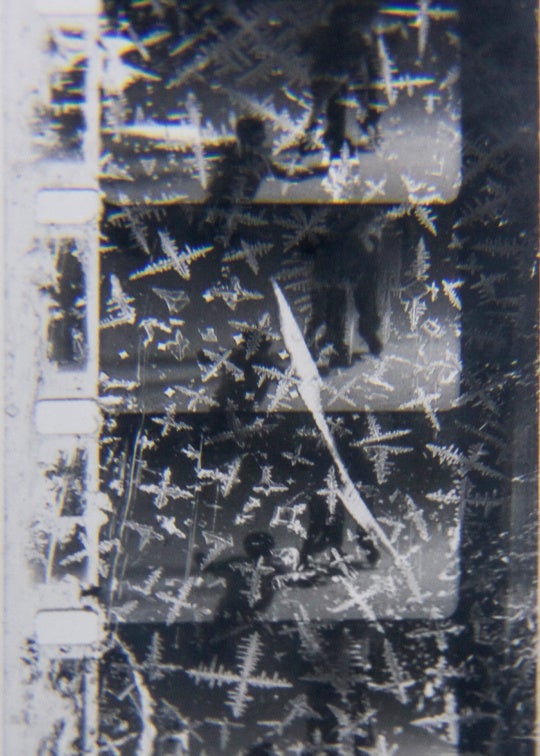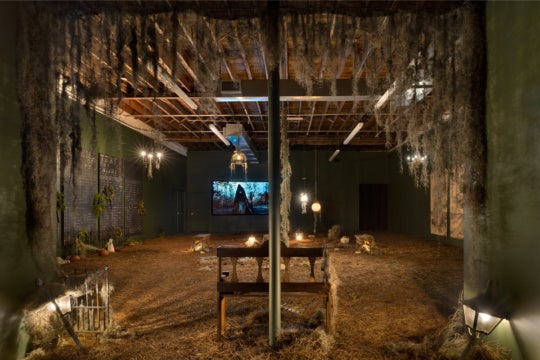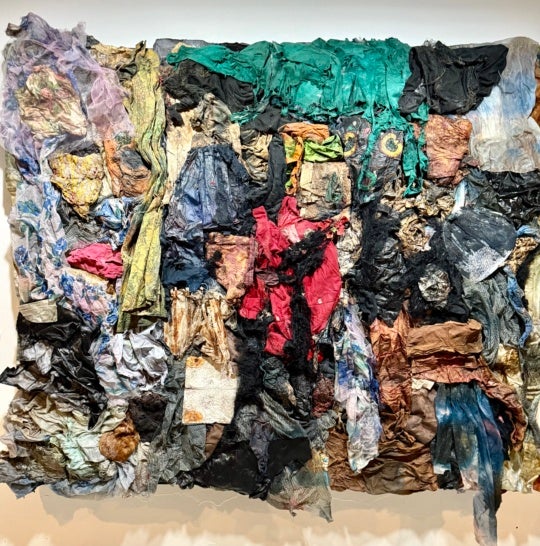Micah Stansell is an Atlanta-based video and installation artist. His most recent production, The Water and The Blood, was projected onto the side of the High Museum during summer 2012. Stansell has received several awards for his work, most recently a 2011 Artadia Award and 2010 Working Artist Project Award from the Museum of Contemporary Art of Georgia.
I recently had the opportunity to sit down with Stansell in his home studio to learn more about his working process, from pre-production to installation.
Rachel Reese: Let’s start with the most recent work, The Water and the Blood (2011-2012).
Micah Stansell: It was first shown at MOCA GA in 2011 and then summer 2012 at the High Museum. That was the work I made as a result of the Working Artist Project Grant for MOCA GA.
RR: What were the sound components for The Water and The Blood, specifically for the High Museum installation, as it was projected on the façade of the museum and in Sifly Piazza?
MS: The music or soundtrack was broadcast via speakers we had placed on top of the building and it spilled down below; it was really beautiful. And there were two vocal tracks. One was a sort of “verbal score” and the other track was actors delivering monologues and you could hear those via headphones, your smart phone, or little speaker stations. They had a very short radius so you could only hear them if you stood around them.
RR: My first reaction to it was Doug Aitkens’ Sleepwalkers, presented in 2007 by projection onto MoMA. We were living in New York at the time so I did get to experience that in the present. It is silent though. Something that struck me was when Roberta Smith reviewed Sleepwalkers, she called it videotecture—an aggregate of video work and architecture. And comparing it to post-modern society, specifically Debord’s Society of the Spectacle where images replace experience—like being in Times Square where the actual walls are the image now, and the way Doug Aitken was using that. But I didn’t know if any of those things were going through your mind when you were making this work?
MS: Yeah, I mean, not really for this. That idea of images replacing experience, especially memories is really interesting. I’ve never seen Sleepwalkers. I would love to have been able to see it in person. I’ve seen stills of the installation—this is a problem with these kinds of large scale installations, it’s really difficult for documentation to approximate the experience of seeing it in person. I think being in New York at MoMA, just a few blocks from Times Square makes those ideas much more relevant. Probably most places, you know, outside of cities like New York or Tokyo, don’t really have that same presence of buildings as billboard. We were really coming off of the work from FLUX, Between You and Me (2010). It was a projection on the side of a building, too. So in a lot of ways I guess it was more of a reaction to that previous work of mine.
RR: An internalizing of the development of your work. Also many scenes remind me of Bill Viola’s videos. What building was used as the projection screen for FLUX?
MS: Yeah, I love that. That cascading water stuff. There are these under water elements that are probably referencing that, at least visually…
Between You and Me was projected onto the Norfolk Southern Railway Headquarters building, this empty building from one of the great American industries, which is now an industry in decline. And you viewed it across this massive gulch where, if you’ve been down to Castleberry Hill all the rail yards are below, all these trains are rumbling through as you’re watching it. Those walls are 80 feet high. They’re massive. You can’t even get the scale of it. Then beyond it is this really modern skyline—this really modern city. That kind of reaction between the work and the site kind of gives it another layer of experience. Also it’s a white building, it becomes a screen so that’s a part of it.
RR: Where was The Water and the Blood filmed?
MS: The Water and the Blood was mostly filmed within an hour or two of Atlanta probably in each direction. We filmed all the lake stuff in Milledgeville, GA. It’s amazing to go an hour or two outside of Atlanta and see how little things have really changed since the late 70’s. The wrestling arena was in a Piggly Wiggly, like a closed Piggly Wiggly. They built a ring in the middle of it. We spent more time researching and pre-producing The Water and the Blood than we did filming and post-production, which is not typical, but for that project it had a lot of locations and a lot of different elements do it.
The Water and the Blood was set in the 70’s—I don’t even know if anybody noticed it was in the 70’s—there’s nothing in the film that was post-1980 because that’s time period for the story that I was recreating. It’s an exploration of one of my father’s stories—actually before I was born—but I inject myself into it. Again, it’s not like a period piece, but we kind of remove anything that directly places it outside of the late 70’s.
RR: So, who do you use in your film? Are they professional actors?
MS: We did a casting call. Atlanta’s got a lot of activity right now in the film industry and that helps me because there are actors and message boards where we can put out a casting call and received an amazing response—we made some tough choices. And then we mix in non-actors. I always like to work with non-actors. I feel like it’s easier to get performances from them that are natural. Actors are used to acting in a way that’s more scripted and not necessarily as fluid. We do a lot of improvisation. Most of the work aside from the monologues—those are directly scripted, that’s when the actors are great because they can take direction notes—is a lot of improvisation, reacting to each other and I follow with the camera. It’s a lot like documentary in that sense. For example, at the wrestling match, the wrestlers were just doing their thing and we had actors there with us and they’re reacting to the space.
RR: How do you present your multi-channel works in a theatre setting versus an installation?
MS: If it’s a big theater, it looks pretty good. I show the multiple channels just straight across—Presynaptic Potential (2009), for example, has been shown just like that. You can make associations much more easily because they’re side-by-side. Most of the installations are really large so you have to navigate the work physically and you can’t see it all at once. Presynaptic Potential was also shown installed on opposing walls and thereby places you in the middle of the work. You’re physically positioned in between these things; you can’t capture that dynamic in a theater. But in a theater, the projection is awesome, it’s totally dark, the seats are comfortable, and sound is amazing. Theatre is made for watching moving images. It’s the best environment in that way so it’s really something I’m interested in exploring. It’s fascinating to do a Q&A after a screening and hear the different kinds of reactions people have versus an installation setting.
RR: Someone experiencing the work by chance on the street (a body in motion), versus a planned audience sitting stagnant in a theater is very different.
MS: And it’s also fascinating how little crossover there is between art-going, museum-going, and festival-going audiences. Because I’m in the middle, I would assume that everybody knows about video artists and installation artists. Probably more people in the art world know film than film audiences know art. Just because film is a more democratic view, people know it—it’s a more universal thing.
RR: What does your editing process look like?
MS: I use mainly Final Cut. And what I do with these multi-frames, there’s a whole workflow that I’ve discovered and developed because it’s so much different. You can’t display eight images across in HD and play them back on a normal computer in real time.

RR: So when you’re working in the editing or post-production phase, are you working on one channel at a time? Or do you go back and forth between them?
MS: I work on one channel and I use a lot of time codes and just writing down queues. I’ll edit in segments. It’s kind of a long developmental process, so…let’s say we’re doing the wrestling scene. I’ll take all the footage and lay it into a timeline and start figuring out what works. So a lot of times I tell actors, “okay we’re going to do this once and then we’ll do it again, though slightly differently” from this other angle. I’m interested in this slippage between the frames, where you can look at it and see this is filmed with multiple cameras from different angles. We’re seeing the same scene from multiple angles at once, but then as you watch you notice that things are slipping and it’s not the same scene from different angles. So is this something that’s supposed to be repeated? Is this supposed to be something that’s happening repetitively? The repetition of the same action multiple times creates a fissure, you know? I like to inject those bits of unreliability into something you think is reliable.
RR: And I get this very uncanny feeling looking at your work…
MS: The idea is that it reengages you and reengages that thought process—you may get swept up in the visual of it—the longer you stay with it and watch it you start to wonder, “why is this happening?” And then it’s extremely loose so inevitably people bring their own context to bear on it. I’m glad it’s not so specific so that it doesn’t allow you to transfer yourself into the work. This is reinforced by everyone chooses what channel to view, so everybody experiences something completely different. There are eight frames and the chance that everybody in there is looking at the same thing, at the same time, is almost zero. It allows for multiple viewings, for people to sit with it longer, and for it to be participatory rather than a passive experience.
RR: Exactly—which I think differentiates your work from film and theater. Would you say you are video artist specifically?
MS: I think that it’s becoming the same thing. Film is a medium that’s being used in specific ways and still exists. Going to film school, you’re talking about cinema, you’re talking about a sense of storytelling with moving images. So you could just use the umbrella of moving images and I would feel comfortable with that. I’ve shot film, a good bit of film, in grad school. It was invaluable; you learn a discipline of using very expensive media and you have to plan ahead, know what your shots are going to be, make sure that you’re exposing them correctly and focusing correctly. It ups the craft of what you’re doing because you can’t afford to buy hundreds of feet of film and then blow it. It’s not this accidental experimentation; it’s a very planned version of experimentation.
RR: Premeditated experimentation.
MS: Yeah. So, I think it really, really informs the way I shoot video. I feel like I shoot video like film. And there’s a very sort of specific way that you’re taught the craft of film, and for good reason, because it’s a very complicated medium to work with.
RR: You have to understand how to manipulate it first.
MS: You have to understand the technical craft of it. In my estimation you have to understand that in order to make good work. And I feel really fortunate to have gone to film school.

RR: And you went to Georgia State’s program?
MS: I went to Georgia State, the master’s program in film. And then I actually transferred into this hybrid program between the art department and the film department that was called Digital Filmmaking and Art. It was a more open format, but I had a great film background that was an advantage to me, because I came out with a high level of understanding of the craft of filmmaking.
RR: How long have you been in Atlanta?
MS: Fall of 2003, Whitney and I moved here.
RR: You’ve been in this neighborhood ever since [College Park, Atlanta]?
MS: More or less. We bought this house in the fall and then we fixed it up for four or five months. And then moved in 2004. It’s convenient—I rode MARTA into Georgia State every day. Faster than I could drive and find somewhere to park.

RR: So what happens in this room specifically?
MS: This is primarily for post-production, but also for all of the pre-production and office work that accompanies the production. It’s something you have to treat like a production. I have notebooks and breakdowns.
RR: You have a production archive of all of your works?
MS: Yeah, in a sense. A lot of it’s moved more digitally recently. I use Google Docs a ton… So this is very kind of dry but refined process that took a long time to develop. And it’s hard because scripts are very loose in what I do. They’re just sort of describing…
RR: There’s room for evolution.
MS: Right, because we react to the space. For a shooting script, it’ll say, “exterior street” but it’s just a generic version of the street. I just focus on the main things we’re trying to achieve with the shot.


RR: Do you use large film crews?
MS: The crews are small. But I always feel a little awkward—because it’s a film, really a lot of people made this. I made the work, but there were all these actors that donated a lot of time. It’s a truly collaborative medium. It’s unlike most of the mediums in the fine arts. This is something that requires other people to help you realize it. I do as much of it as humanly possible, but there’s no way I could do it all by myself. It’s always a little awkward for me to be like, this is my work. At film festivals, everybody gets credit, but in installations, there’s no credit. I always have a postcard or wall graphic or press release. But people don’t always look at it. I would like to be able to say, “All these people made this with me!”
 Presented in partnership with BOMB Magazine—the artist’s voice since 1981.
Presented in partnership with BOMB Magazine—the artist’s voice since 1981.




